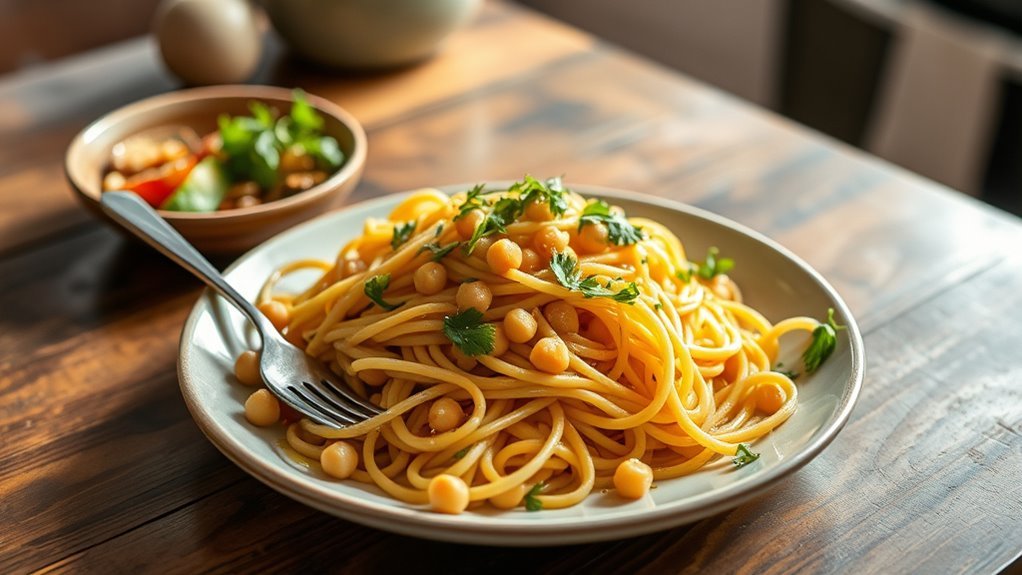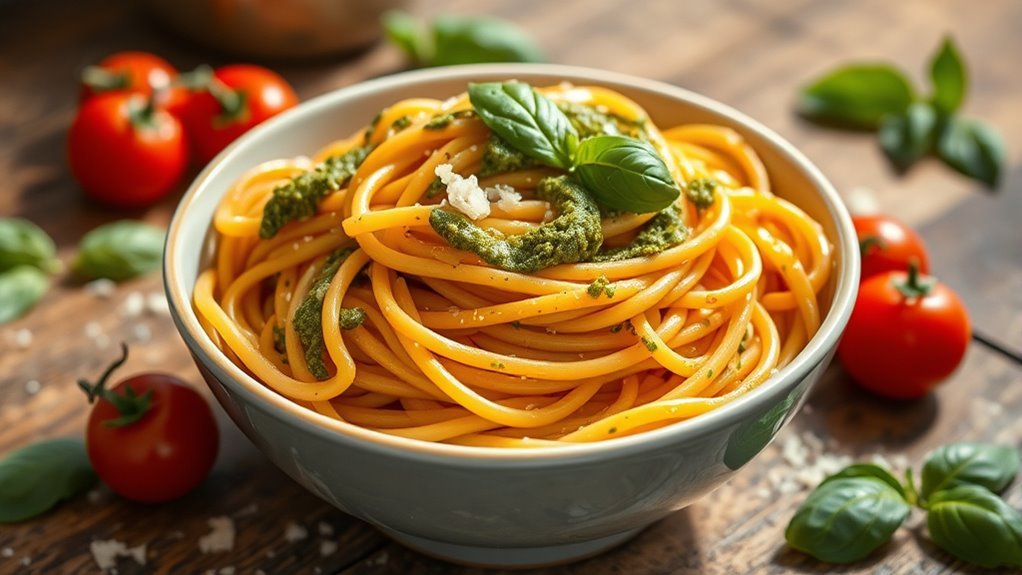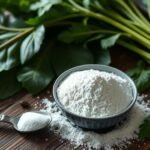Chickpea pasta isn’t typically considered keto-friendly due to its higher carbohydrate content, which averages around 30 grams per serving. For those on a strict ketogenic diet aiming for 20-50 grams of carbs daily, this could easily push you over your limit and disrupt ketosis. While it provides a healthier alternative to traditional pasta, incorporating it into a keto meal plan requires careful management of your overall carb intake. Learn more about suitable alternatives and integration strategies.
What Is Chickpea Pasta?

Chickpea pasta, often hailed as a nutritious alternative to traditional wheat pasta, is made primarily from ground chickpeas. Its origins trace back to regions like the Middle East and Mediterranean, where chickpeas have been cultivated for thousands of years. This legume’s rich history contributes to the diverse pasta varieties available today, such as penne, fusilli, and spaghetti, all crafted from chickpea flour. By choosing chickpea pasta, you’re opting for a gluten-free option that aligns with modern dietary trends. It caters to those seeking plant-based alternatives, while also adding unique flavors and textures to dishes. Understanding these origins and varieties can enhance your culinary experience, allowing you to explore the versatility chickpea pasta offers in your meals.
Nutritional Profile of Chickpea Pasta

When considering chickpea pasta, it’s important to analyze its nutritional profile, particularly its carbohydrate content. You’ll find that chickpea pasta offers a unique balance of protein and fiber, which can be beneficial for your diet. Additionally, a comparison of its micronutrients reveals how it stacks up against traditional pasta options, making it a significant alternative.
Carb Content Analysis
Analyzing the nutritional profile of chickpea pasta reveals that it contains approximately 30 grams of carbohydrates per serving, making it a notable alternative to traditional wheat pasta. While chickpea benefits include a higher fiber content, it’s essential to take into account how these carbs fit within keto guidelines. If you’re aiming for a strict ketogenic diet, monitoring your carb intake is vital.
| Nutritional Component | Amount per Serving |
|---|---|
| Carbohydrates | 30 grams |
| Fiber | 8 grams |
| Protein | 14 grams |
With about 30 grams of carbs, chickpea pasta may challenge your keto goals. However, its nutritional value can still offer a satisfying option when you choose wisely!
Protein and Fiber Benefits
While the carbohydrate content of chickpea pasta can be a concern for those on a strict keto diet, its protein and fiber benefits present a compelling case for consideration. Chickpea pasta is rich in high-quality protein sources, making it an excellent choice for those seeking to increase muscle mass or maintain energy levels. Furthermore, it contains various fiber types that support digestive health and promote satiety, which can help curb cravings.
- Boosts your energy levels naturally
- Supports healthy digestion and gut health
- Provides sustained fullness, reducing snacking
- Offers a plant-based protein option for diverse diets
- Enhances nutrient absorption
Incorporating chickpea pasta can provide nutritional advantages that resonate with your desire for freedom in dietary choices.
Micronutrient Comparison
Chickpea pasta offers a unique nutritional profile that sets it apart from traditional wheat pasta, especially in relation to micronutrients. Its micronutrient density includes essential vitamins and minerals like folate, iron, and magnesium, which support various bodily functions. These nutrients play a vital role in energy production, immune function, and muscle health. Compared to wheat pasta, chickpea pasta enhances nutrient absorption due to its higher fiber content, which aids in digestive health and helps regulate blood sugar levels. By incorporating chickpea pasta into your diet, you’re not only diversifying your meals but also enriching your nutrient intake. This makes it an appealing option for those seeking healthier alternatives while adhering to specific dietary needs.
Carb Content Comparison: Chickpea Pasta vs. Traditional Pasta

When evaluating dietary choices, it’s important to compare the carb content of chickpea pasta with traditional wheat pasta. Chickpeas, with origins tracing back to the Middle East, offer a different nutritional profile compared to conventional pasta varieties. Typically, chickpea pasta contains around 30-40 grams of carbs per serving, while traditional pasta can have about 40-60 grams.
Here are some emotional factors to evaluate:
- Your energy levels post-meal
- The joy of exploring new flavors
- The satisfaction of making healthier choices
- Your personal dietary goals
- The impact on your overall well-being
The Role of Fiber in Chickpea Pasta
When considering chickpea pasta, it’s essential to examine its fiber content compared to traditional pasta. This dietary fiber offers various health benefits, including improved digestive health and enhanced satiety. Understanding these aspects can help you make informed choices about incorporating chickpea pasta into your diet, especially within a keto framework.
Fiber Content Comparison
Although many pasta alternatives are available, chickpea pasta stands out for its impressive fiber content, which plays an essential role in digestive health. When comparing fiber types, chickpea pasta offers both soluble and insoluble fiber, making it a superior choice among various fiber sources. This balance can help regulate your digestion while enhancing feelings of fullness.
- It supports a healthy gut.
- It aids in weight management.
- It promotes stable blood sugar levels.
- It helps lower cholesterol.
- It contributes to overall well-being.
Health Benefits of Fiber
While many people overlook the significance of fiber in their diets, the health benefits of the fiber found in chickpea pasta are remarkable. This pasta serves as an excellent fiber source, providing you with essential nutrients that support overall well-being. Fiber plays a vital role in maintaining a healthy digestive system, promoting regularity, and preventing constipation. By incorporating chickpea pasta into your meals, you’re not just enjoying a tasty alternative; you’re also enhancing your fiber intake, which can help manage weight and reduce the risk of chronic diseases. Additionally, the fiber in chickpeas aids in stabilizing blood sugar levels, offering further health advantages. Embracing this nutritious option can be a liberating choice for your dietary freedom and wellness journey.
Digestive Health Impact
Since fiber is an essential component of digestive health, the high fiber content in chickpea pasta can greatly benefit your gastrointestinal system. Incorporating chickpea pasta into your diet can enhance gut health and provide several digestive benefits.
- Promotes regular bowel movements
- Reduces bloating and discomfort
- Supports the growth of healthy gut bacteria
- Helps maintain a balanced pH in the intestines
- Aids in nutrient absorption
Impact on Ketosis: Can Chickpea Pasta Kick You Out?
How does chickpea pasta stack up against the strict carbohydrate limits of a ketogenic diet? While it offers a nutritious alternative to traditional pasta, chickpea pasta isn’t always keto-friendly. Typically, it contains around 30 grams of carbs per serving, which can quickly exceed the keto guidelines of keeping daily intake under 20-50 grams. If you’re aiming for ketosis, even a single serving might kick you out, as your body relies on low carb consumption to maintain fat-burning. Although it’s a healthier pasta alternative, if you’re committed to the ketogenic lifestyle, you’ll need to be cautious. Consider other options like zucchini noodles or shirataki pasta, which align better with your keto goals while still giving you that satisfying texture.
How to Incorporate Chickpea Pasta in a Keto Diet
If you’re set on enjoying chickpea pasta while following a ketogenic diet, it’s essential to be strategic about portion sizes and pairings. You can still savor delicious chickpea pasta recipes without compromising your keto goals. Focus on smaller servings and balance your plate with plenty of low-carb vegetables and healthy fats.
Consider these tips for effective keto meal prep:
- Combine with spinach or zucchini for added nutrients.
- Use olive oil or avocado for healthy fat.
- Add protein sources like grilled chicken or shrimp.
- Pair with a low-sugar tomato sauce or pesto.
- Experiment with herbs and spices to enhance flavor.
Alternatives to Chickpea Pasta for Keto
While chickpea pasta can be a satisfying option, there are several alternatives that align more closely with keto guidelines, particularly due to their lower carbohydrate content. Zucchini noodles, or “zoodles,” are a popular choice, offering a light, versatile base for various dishes while being low in carbs. They’re easy to prepare and can absorb flavors well. Another excellent option is shirataki rice, made from konjac root. This rice alternative is virtually calorie-free and low in carbs, making it perfect for maintaining ketosis. Both zucchini noodles and shirataki rice can help you enjoy your favorite pasta dishes without compromising your keto goals, allowing for more freedom in your meal planning while keeping your carbohydrate intake in check.
Recipes Featuring Chickpea Pasta
Although chickpea pasta may not fit neatly into a traditional ketogenic diet, it can still be incorporated in moderation to create delicious and satisfying dishes. You can explore various recipes that showcase its versatility and flavor. Consider these options:
Chickpea pasta offers a tasty alternative for creative dishes, even within a moderate ketogenic approach.
- Chickpea pasta salads packed with fresh veggies and a zesty dressing.
- Chickpea pasta bakes layered with cheese and rich sauces for ultimate comfort.
- A hearty chickpea pasta primavera loaded with seasonal produce.
- Creamy chickpea pasta tossed in a savory garlic sauce.
- A revitalizing chickpea pasta pesto combined with aromatic herbs.
These recipes not only satisfy your cravings but also allow you to enjoy a creative culinary experience while steering through your dietary choices. Embrace the freedom of flavor!
Final Thoughts on Chickpea Pasta and Keto
As you navigate the complexities of a ketogenic diet, it’s important to recognize that chickpea pasta can serve as a nuanced alternative for those seeking variety in their meals. While it offers several chickpea pasta benefits, such as being high in protein and fiber, it’s vital to weigh these against essential keto diet considerations. Chickpea pasta typically contains more carbohydrates than traditional low-carb options, which may hinder ketosis for strict dieters. However, if you’re looking to incorporate it occasionally without derailing your goals, monitoring your overall carb intake is key. Ultimately, the decision to include chickpea pasta should align with your personal dietary preferences and goals, allowing you to enjoy a broader array of flavors while staying mindful of your keto journey.
Frequently Asked Questions
Is Chickpea Pasta Gluten-Free?
Yes, chickpea pasta is gluten-free, making it a great option for those with gluten sensitivities or celiac disease. It offers chickpea benefits like high protein and fiber content, which can help you feel full longer. This pasta serves as a nutritious gluten alternative, providing a satisfying texture without the typical downsides of traditional wheat pasta. If you’re looking for a healthy, versatile option, chickpea pasta could be an ideal addition to your diet.
Can I Eat Chickpea Pasta on a Low-Carb Diet?
If you’re on a low-carb diet, you’ll want to be cautious with chickpea pasta. While it offers nutritional benefits like protein and fiber, it’s higher in carbs compared to traditional pasta. Portion control is essential; a small serving might fit your goals, but larger portions can quickly add up. Always consider your overall daily carb intake and how chickpea pasta can fit into your meal plan without derailing your diet.
How Does Chickpea Pasta Taste Compared to Traditional Pasta?
When comparing chickpea pasta to traditional pasta, you’ll notice distinct differences in the flavor profile and texture. Chickpea pasta has a nuttier taste, which can enhance your dishes, while traditional pasta offers a more neutral flavor. Regarding texture, chickpea pasta tends to be slightly denser and chewier, providing a satisfying bite. If you enjoy experimenting with new flavors and textures, you might find chickpea pasta a delightful alternative to classic options.
What Are the Cooking Methods for Chickpea Pasta?
When you’re whipping up a meal, chickpea pasta offers various cooking methods to explore. You can boil it like traditional pasta, but keep an eye on cooking times, as it tends to cook faster. Sautéing with veggies brings out its flavor, while baking it in casseroles adds a delightful texture. For preparation tips, always rinse it before cooking to reduce stickiness. Embrace these cooking techniques for a delicious twist on your favorite dishes!
Are There Any Allergens in Chickpea Pasta?
When considering chickpea pasta, you should be aware of potential allergen concerns. While it’s generally gluten-free and offers nutritional benefits like protein and fiber, it can trigger reactions in individuals with chickpea or legume allergies. Always check labels, as cross-contamination with other allergens might occur during processing. If you’re unsure about your sensitivities, it’s wise to consult a healthcare professional before incorporating chickpea pasta into your diet.


